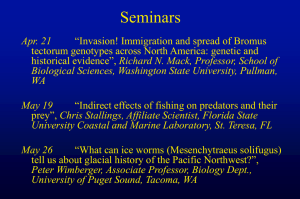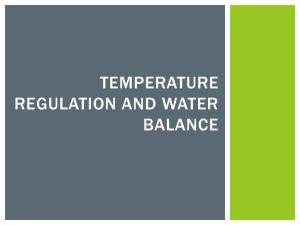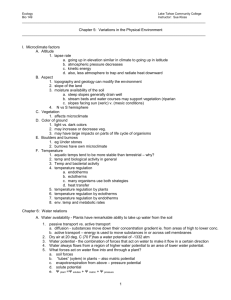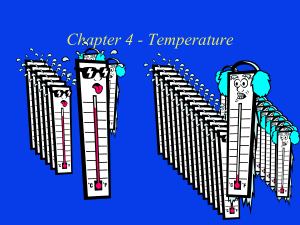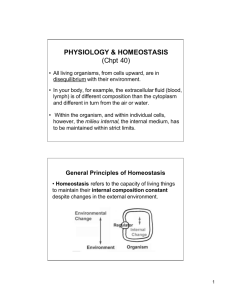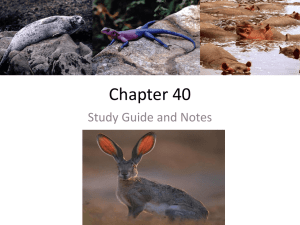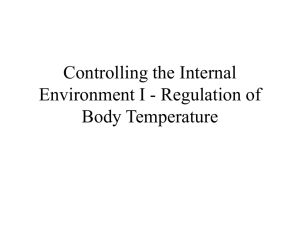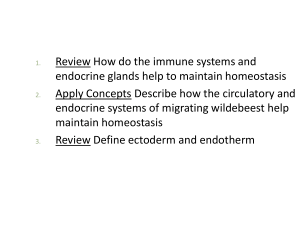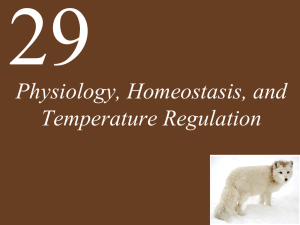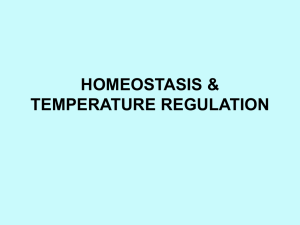Regulating the Internal Environment
advertisement
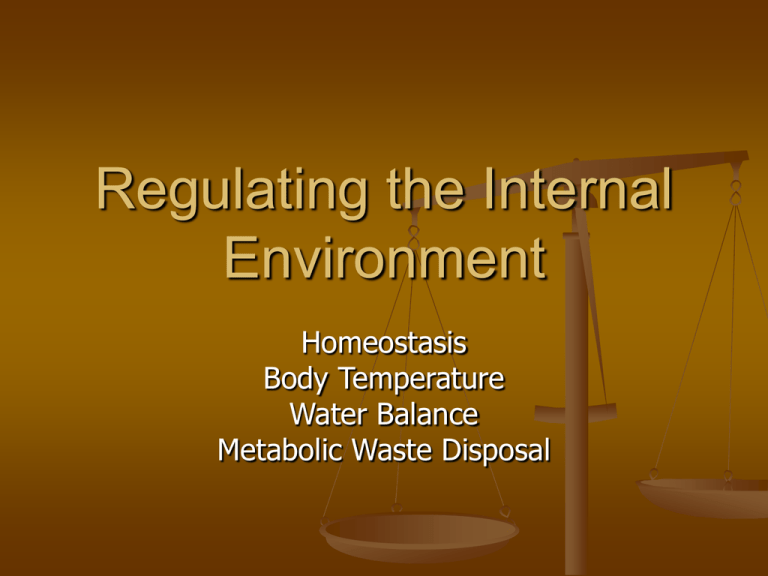
Regulating the Internal Environment Homeostasis Body Temperature Water Balance Metabolic Waste Disposal Homeostasis Overview Regulators – internal change is moderated in a changing environment e.g. birds Conformers – allow internal change with certain external changes Budget = balance of loss and gain, animals are open systems e.g. water maintenance via intake overcomes losses via breathing, sweating, urination, etc. Q10 Effect The multiple by which a particular enzymatic reaction or overall metabolic process increases with a 10°C temperature change in the body. For example, if the hydrolysis of amylose into maltose is 3.7 times greater at 25°C than at 15°C in fire belly toads, the Q10 is 3.7 for that reaction. Each animal has an optimal range of temp If it’s warmer, I digest faster. Heat Loss Conduction = direct transfer of heat from cold water or hot rock Convection = transfer of heat by movement, wind Radiation = emission of electromagnetic waves by all objects greater than absolute zero, sun Evaporation = water needs a lot of energy to evaporate, sweat, humidity Ectotherms vs Endotherms Ectotherms have such low metabolic rates that they rely mostly on the environment to determine their body temp Endotherms have such high metabolic rates that body temp is higher than the environment Endotherms have an advantage, but it is costly! Thermoregulation Insulation – many organisms have fat as an insulator. Vasodilation vs vasoconstriction Countercurrent heat exchange – minimize heat loss in the extremities by allowing for close proximity of arteries and veins – venous blood is warmed by arterial blood as it re-enters the body from the limbs. Thermoregulation Cont. Evaporative heat loss cools terrestrial animals. Behavioral responses – basking in the sun, warm rocks, find shade, enter cool water, hibernation, migration Change in metabolic rate - endotherms Mammals and Birds Heat can be increased by movement of muscles including shivering. NST – nonshivering thermogenesis – certain animals have mitochondria that increase their metabolic activity to produce heat instead of ATP Insulation Sweating, panting, Amphibians and Reptiles Temperature controlled mostly by behavior Some extras: bull frogs secrete mucous, marine iguanas of the Galapagos – vasoconstriction, female pythons “shiver” to become endothermic when incubating eggs Dinosaurs? Fish! Most are ectotherms except for a few large active fish such as the great white shark, swordfish and bluefin tuna. They maintain a countercurrent exchange with large arteries full of cold blood from the gills entering tissues just below the skin. Branches deliver oxygenated blood to deep muscles. Invertebrates Most are ectotherms Some flying insects are endotherms – Hawk moth, bumblebees, honey bees – they use flight muscles to generate heat Bumble bee queens can us countercurrent exchange to allow heat to release from the thorax and incubate eggs. Bumble bees also huddle Feedback Mechanisms Thermoregulation – see teachers flow chart. Acclimatization Endotherms - insulation layer Ectotherms – metabolic processes – enzymes may have different forms at different times of the year = temperature, cellular membranes may have a higher concentration of unsaturated fats based on temp “antifreeze” - prevents ice crystalization in fish, frogs, arthropods and their eggs Heat shock Proteins Found mostly in tissue culture, they are proteins that maintain the stability of other proteins, keep them from denaturing in either stress or heat. Found in yeast, bacteria, plant cells and animal cells! Torpor Physiological state of inactivity Hibernation Estivation Osmoregulation Management of the body’s water content and solute(salt) content. Transport Epithelium Layer or layers of specialized epithelial cells that regulate solute movement. Prevalent in marine birds and ocean fish. Remove salt to maintain water balance. Nitrogenous Wastes Ammonia – common in aquatic species, lost from epithelial tissue of gills, kidneys relatively inactive. In freshwater exchange of Na+ into cells and NH4+ out. Urea – produced by liver, less toxic than , water soluble NH4, organisms use energy to make and lose water to remove it. Amphibians probably switch. N waste continued Uric acid – land snails, insects, birds and many reptiles Even less toxic than urea and can be excreted with less water loss as a semisolid paste. Costs more energy than urea Build up of urea in an egg may be toxic Osmotic Balance Over time the uptake and removal of water must balance in all animals. Remember what happens to an animal cell in salt water or distilled water? Osmoregulator Animal that must continually adjust its internal osmolarity because it is not the same as its environment. Osmoconformer Animal’s inner osmolaritly is equal to its surroundings – isoosmotic I’m the only vertebrate that is an osmoconformer! You are one ugly hag! Fish have special problems Marine fish have the dilemma or too much salt and possible water loss via direct contact with water and gill epithelial cells. They excrete excess salt via gills and scant urine. Obtain water from gills and food. Chondricthyes have a rectal gland that removes salt – special organ Freshwater fish excrete large amounts of water through very dilute urine. Anhydrobiosis Some arthropods and rotifers can survive for many years in a dried out state Excretory Systems Selective reabsorption – body accumulates fluid, and maintains water balance through reabsorption of some solutes and secretion of others. Fluid is accumulated by filtration – blood pressure or hydrostatic pressure accumulate the nitrogenous waste. Protonephridia Network of dead-end tubules lacking internal openings. They branch through the body with the smallest ones capped by a flame bulb.(Osmoregulation mostly) It has a tuft of cilia that draws the water out of the tubule to the outside. Most of metabolic waste is removed via diffusion. Metanephridia Internal openings that collect body fluids and remove it via cilia. Found in most Annelids – earthworms have two per segment. Remove nitrogenous waste and osmoregulate as well. Malphigian tubules Insects and other terrestrial arthropods Removes nitrogenous waste and maintains water balance. Collects and then leads to rectum. Most of the water is reabsorbed into the hemolymph and waste is secreted with feces. The Kidney! A = Blood, arteries and veins B = Renal Calyx C = Ureter D = Renal Medulla E = Renal Cortex Label animation for nephron Step by step animation
